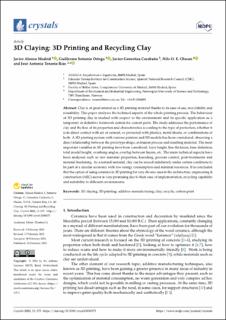| dc.contributor.author | Madrid, Javier Alonso | |
| dc.contributor.author | Ortega, Guillermo Sotorrío | |
| dc.contributor.author | Carabaño, Javier Gorostiza | |
| dc.contributor.author | Olsson, Nils Olof Emanuel | |
| dc.contributor.author | Ríos, José Antonio Tenorio | |
| dc.date.accessioned | 2023-03-14T09:03:10Z | |
| dc.date.available | 2023-03-14T09:03:10Z | |
| dc.date.created | 2023-02-24T13:11:28Z | |
| dc.date.issued | 2023 | |
| dc.identifier.citation | Crystals. 2023, 13 (375), . | en_US |
| dc.identifier.issn | 2073-4352 | |
| dc.identifier.uri | https://hdl.handle.net/11250/3058085 | |
| dc.description.abstract | Clay is of great interest as a 3D printing material thanks to its ease of use, recyclability and reusability. This paper analyses the technical aspects of the whole printing process. The behaviour of 3D printing clay is studied with respect to the environment and its specific application as a temporary or definitive formwork system for cement parts. The study addresses the performance of clay and the loss of its properties and characteristics according to the type of protection, whether it is in direct contact with air or cement, or protected with plastics, metal sheets, or combinations of both. A 3D printing system with various printers and 3D models has been considered, observing a direct relationship between the prototype shape, extrusion process and resulting material. The most important variables in 3D printing have been considered: layer height, line thickness, base definition, total model height, overhang angles, overlap between layers, etc. The main technical aspects have been analysed such as raw material properties, kneading, process control, post-treatments and material hardening. As a natural material, clay can be reused indefinitely under certain conditions to be part of a circular economy with low energy consumption and minimal resources. It is concluded that the option of using ceramics in 3D printing for very diverse uses in the architecture, engineering & construction (AEC) sector is very promising due to their ease of implementation, recycling capability and suitability to different environments. | en_US |
| dc.language.iso | eng | en_US |
| dc.publisher | MDPI | en_US |
| dc.rights | Navngivelse 4.0 Internasjonal | * |
| dc.rights.uri | http://creativecommons.org/licenses/by/4.0/deed.no | * |
| dc.title | 3D Claying: 3D Printing and Recycling Clay | en_US |
| dc.title.alternative | 3D Claying: 3D Printing and Recycling Clay | en_US |
| dc.type | Peer reviewed | en_US |
| dc.type | Journal article | en_US |
| dc.description.version | publishedVersion | en_US |
| dc.source.pagenumber | 20 | en_US |
| dc.source.volume | 13 | en_US |
| dc.source.journal | Crystals | en_US |
| dc.source.issue | 3 | en_US |
| dc.identifier.doi | https://doi.org/10.3390/cryst13030375 | |
| dc.identifier.cristin | 2128980 | |
| cristin.ispublished | true | |
| cristin.fulltext | original | |
| cristin.qualitycode | 1 | |

